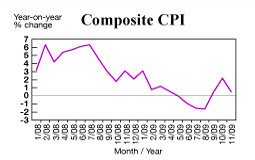
|
| Higher costs: Consumer prices grew 0.5% year-on-year in November, following a 2.2% rise in October. |
Consumer prices grew 0.5% year-on-year in November, following a 2.2% rise in October, the Census & Statistics Department announced today.
The larger year-on-year rate of change in October was attributable to the low base of comparison arising from the Government's payment of public housing rentals in October 2008, and such effect did not come into play in November.
Netting out the effects of the Government's one-off economic relief measures, the year-on-year rate of change in the composite consumer price index in November was -0.3%, the same as October.
On a seasonally adjusted basis, the average monthly rate of change in the composite consumer price index for September to November was 1%, which compared to 0.4% for the August to October period.
Netting out the effects of all the Government's one-off relief measures, the average monthly rate of change in the composite consumer price index for September to November was 0.2%, and that for the August to October period was 0.1%.
Deflationary pressure recedes
The department said underlying composite consumer price index inflation, on a year-on-year comparison, remained stable at a slightly negative level in November.
On a seasonally adjusted basis, the average monthly rate of change turned slightly positive in recent months, indicating deflationary pressure in the economy has receded, now economic recovery has started.
Inflationary pressure should stay muted in the near term, as the economic recovery is still at an early stage and as import prices remain soft, the department added.
Year-on-year increases were recorded in electricity, gas and water (31.7%), alcohol and tobacco (21.8%), clothing and footwear (2.8%), miscellaneous goods (2.1%) and meals bought away from home (0.5%).
Decreases were recorded in durable goods (-3.5%), food excluding meals bought away from home (-2.2%), and miscellaneous services (-1%).
|